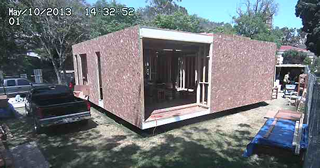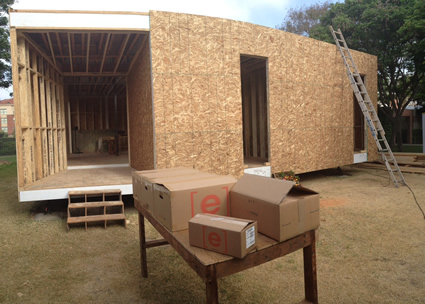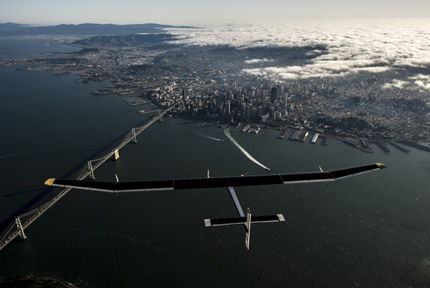Welcome to the
Run on Sun Monthly Newsletter

In this Issue: |
May, 2013
Volume: 4 Issue: 5
Enphase Joins the Team:
|
|
|
USC's Solar Decathlon Team keeps building steam with the latest boost coming from our good friends over at Enphase Energy. |
Enphase just donated 36 M215 microinverters complete with cabling and an Envoy monitoring system for fluxHome™ - USC's Solar Decathlon entry.
As you can see from this image taken from the live feed, fluxHome is really starting to take shape.
The donation from Enphase - along with earlier contributions - means that the equipment needs for the solar component of the project have all been met. Now the USC team will be able to demonstrate to the thousands attending the Solar Decathlon this October down in Irvine how each individual solar module is producing power thanks to the module level monitoring provided by the Enphase system.
Given that one of the ten competitions in the Decathlon is Communications, this augmented ability to show the public what the solar system is doing could be a key component of an overall communication strategy.
We at Run on Sun are proud of our role - minor though it may be - in helping to make this donation happen and we are confident that the brilliant and dedicated team at USC will make the most of this opportunity.
The gear in these boxes will soon be helping Team USC to power fluxHome in the Solar Decathlon competition - and ultimately, they will be providing clean power for a lucky family in the neighborhood around USC.
Way to go, Enphase - way to go, Team USC! Fight on!!!
“Enphase microinverters will soon be seen atop USC's fluxHome™…”
Help Us Spread the News!






Solar Impulse Soars Across AmericaIf there is anything cooler than a solar-powered airplane that can fly at night, we sure haven't seen it.
Here are some specs of the Solar Impulse:
Indeed, the plane has already garnered Five World Records including:
But how, you may ask, does a solar powered plane fly at night? Clearly it is not fast enough to chase the sun, so what happens when the sun goes down? It is all about energy management - both electrical and potential. During daylight, as the nearly 12,000 solar cells are producing power, the plan climbs toward its service ceiling. As it goes higher, the solar power system becomes more efficient due to both the drop in temperature and the thinning of the atmosphere. Thus, the plane is able to store energy in two forms: electro-chemical (in the batteries) and potential in the altitude attained. When the sunlight fades, the plane begins a very gradual descent, aided by its massive wingspan - equivalent to an Airbus A340 jetliner - that allows it to glide long distances forward for every foot of descent. Finally it levels off and flies at a very slow cruising speed powered by the solar power now stored in its batteries until it once again meets the sun and can begin its ascent once again. In theory, the plane could do this perpetually - not so the poor pilot! Speaking of the pilots, one of them, Bertrand Piccard, has quite the lineage as a pioneer. His father, Jacques Piccard was aboard the Bathyscaphe Trieste (designed by his father, Auguste) when it descended to the ocean floor in the Mariana Trench - some 35,814' deep - in 1960! |
Run on Sun & KPCC Partner to Provide Solar Benefits
Here is the deal as shown on KPCC's Member Benefits page:
To qualify for this special offer, just show us your Benefits Card when we come out to do your free solar site evaluation. Wait, what, you aren't a KPCC Member yet? No worries - just click over to the KPCC website and make a one-time contribution of $60! (Wow, how is that for an immediate return on your investment?) Or better yet, become a sustaining member. It is the ultimate win-win! |



